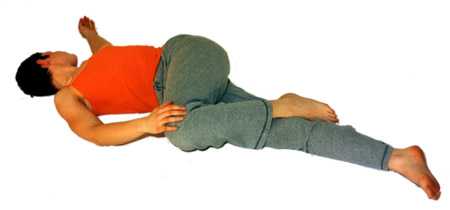

Navasana — Boat
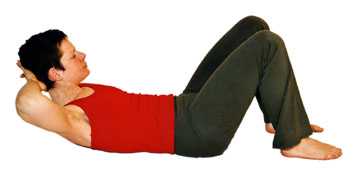 «Navasana» — the «Boat Posture»
«Navasana» — the «Boat Posture»
«Navasana», the «Boat Posture», is an Asana from Hatha Yoga which is one of the 84 Main Asanas. It does not belong to the 12 Basic Postures of the Yoga-Vidya Basic Series, but is often practiced after «Surya Namaskar», the «Sun Salutation». «Navasana», the «Boat», strengthens the center, promotes self-confidence and is a good exercise for strengthening the straight and lateral abdominal muscles.
«Navasana» is composed of «Nava» and «Asana». The Sanskrit word «Nava» has many meanings. «Nava» means «new», «unused», and «fresh». «Nava» is also the number nine, the digit nine. «Nava» with two long a's, so nāvā, means boat and clearly refers to the word «Navasana» meant here, that means the «Boat Posture». The main effects of «Navasana» are activation of the solar plexus, the «Manipura Chakra» and strengthening of the abdominal muscles. As a result, the lower back is better protected, back pains can decrease.
In Hatha Yoga, a general distinction is made between three Asanas. The standing, sitting and the lying postures. «Navasana» belongs to the lying postures. Another «Variation of the Boat Position» is a Variation of the «Locust», also called the «Boat», «Shalabhasana».
Table of Contents
1.1.1 Strengthened Muscles
Mental Effect
1.3 Energetic Effect
1.3.1 Chakras Addressed
2 General Information about Navasana, the Boat (Abdominal Muscle Exercise in the Yoga Vidya Series)
3 Exercise Videos and Announcements on Navasana — Abdominal Muscle Exercises
3.1 Gentle Abdominal Muscle Exercise for Beginners — Practical Instruction
3.3 Simple Variation
3.4 Simple Variation with Lateral Abdominal Muscle Exercise
3.5 Navasana — Abdominal Muscle Exercise with Diagonal Pressure
3.6 Navasana with Hands on Head and Legs Crossed
3.7 Navasana — Dynamic Abdominal Muscle Exercise
3.8 Variation — Abdominal and Thigh Muscle Exercise
3.9 Exercise Video of Abdominal Muscle Exercises from Yoga with Different Variations
3.10 Navasana on the Belly
4 Counter-Position to Navasana or the Abdominal Muscle Exercise: Nakarasana or Garbhasana
4.1 Nakarasana, Crocodile
4.2 Garbhasana, Position of the Child
4.3 Protecting the Lower Back — but how?
Effects of Navasana
Physical Effect
«Navasana» strengthens the abdominal muscles, therefore preventing back pain and a hollow back. By tensing, the abdominal muscles can subsequently relax better which is facilitated by deep abdominal breathing, after which abdominal breathing becomes easier.
Strengthened Muscles
- rectus abdomini (straight abdominal muscle)
- obliquus + transversus abdomini (oblique abdominal muscles)
Mental Effect
«Navasana» develops inner self-confidence and balance, also it is good for harmonization and grounding during emotional fluctuations. «Navasana» helps to develop all the sun qualities, such as assertiveness, willpower and courage.
Energetic Effect
«Navasana» is a centering Asana that allows the «Prana» to flow more easily.
Chakras Addressed
- Manipura Chakra
General Information about Navasana, the Boat (Abdominal Muscle Exercise in the Yoga Vidya Series)
An important part of the Yoga Vidya Series is the Abdominal Muscle Exercise. It is important to have strong abdominal muscles in order to be able to perform certain Asanas at all. The abdominal muscles also serve to protect the lower back. In the Abdominal Muscle Exercise, the practitioner lies on his back with his legs bent and his feet placed in front of his buttocks. The lower back is pressed into the ground with the help of the abdominal muscles, the arms and hands lying at the sides of the head.
Then the practitioner raises the upper body using the strength of his abdominal muscles and holds it above for as long as he can. This exercise should be practiced for 2 to 5 minutes. To exercise the lateral abdominal muscles, the practitioner can simply lift the body toward one side of the body, hold it for as long as possible, and then perform the same exercise toward the other side. The legs can also be lifted at right angles and tilted to the side during the lateral abdominal muscles exercise.
The «Boat» strengthens the abdominal muscles, a hollow back and back problems are prevented. When a muscle is tensed for 5 seconds, it can relax much better afterwards. So also the abdominal muscles can relax much better after the abdominal muscle exercise and so also the solar plexus. The «Prana» can then flow much more easily. Because «Navasana» has such a strong effect on the «Manipura Chakra» and the solar plexus, the Asana helps the practitioner to come into balance and harmonizes emotional fluctuations through the strong physical effort.
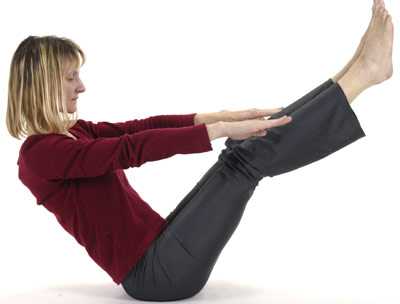 This is the actual Basic Position of «Navasana». However, it should only be practiced by advanced practitioners with good body awareness and practiced completely correctly. Performed incorrectly, this position can be harmful to the lower back.
This is the actual Basic Position of «Navasana». However, it should only be practiced by advanced practitioners with good body awareness and practiced completely correctly. Performed incorrectly, this position can be harmful to the lower back.
Exercise Videos and Announcements on Navasana — Abdominal Muscle Exercises
Gentle Abdominal Muscle Exercise for Beginners — Practical Instructions
In this exercise video, Sukadev guides you through a Gentle Yoga Abdominal Muscle Exercise and explains in detail what you should pay attention to or how you can perform the exercise in a body-friendly way.
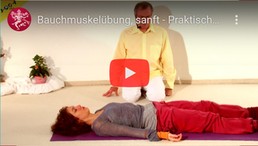
 |
 |
Simple Variation
Starting Position «Back Relaxation Position» (typically in the Yoga Vidya Series):
- Bring both legs together. Protect the lower back and activate the abdominal muscles. Place the feet behind the buttocks, lifting the lower legs. The legs form a 90 degree angle.
- Form a basket at the back of the head with the hands. Raise the head slightly, keeping the nape in line with the thoracic spine. Lift the upper body upwards with the strength of the abdominal muscles, less with the strength of the back muscles.
- Relax everything that you do not need for this Asana. Keep the position calm and relaxed. Smile.
- Continue to breathe deeply into the abdomen. Feel how the abdominal muscles working, feel the warmth building.
- If you want to challenge yourself more: lift your tailbone slightly. One impulse is enough. Pull the belly button inward at the same time. Gives six-pack abs. (Can, however, also be a hindrance during «Pranayama» again, so pay attention to skillful progress).
- Hold the position only as long as it is comfortable, go to your limits. Keep smiling. Hold for 5 more breaths.
- Release the position slowly and consciously exhaling.
- Intermediate relaxation: 5-8 breaths deep into the belly. You may notice a deeper abdominal breathing. Prepare yourself internally for two more repetitions.
- If you want to challenge yourself more now, bring your bent knees further forward in «Navasana».
- More demand by straightening your legs. Always take care of your lower back/lumbar region.
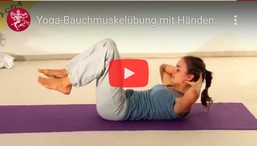
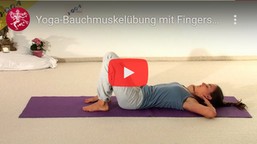
Simple Variation with Lateral Abdominal Muscle Exercise
Starting Position «Back Relaxation Position» (typically in the Yoga Vidya Series):
- Bring both legs together. Protect the lower back and activate the abdominal muscles. Place the feet behind the buttocks. Raise the lower legs, the legs forming a 90 degree angle.
- Form a basket at the back of the head with the hands. Raise the head slightly, keeping the nape in line with the thoracic spine. Lift the upper body upwards using the strength of the abdominal muscles, not the strength of the back muscles.
- Relax everything that you do not need for this Asana. Hold the posture calmly and relaxed. Smile.
- Continue to breathe deeply into the abdomen. Feel how the abdominal muscles working, feel the warmth building.
- Exhale and inhale bringing the right elbow to the left knee. Hold this position. Feel the lateral abdominal muscles working.
- Return to the middle. Now the other side. Bring the left elbow to the right knee. Holding and breathe deeply into the abdomen.
- Hold the position only as long as comfortably doable, go to your limits. Keep smiling. Come back to the middle.
- Slowly and consciously exhaling release this position.
- Important: Relax, breathe deeply into the belly. Relax the muscles. The abdominal wall rises when inhaling, the abdominal wall lowers when exhaling. Relax for 5-8 breaths in between.
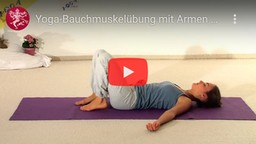
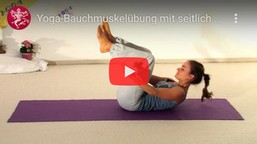
Navasana — Abdominal Muscle Exercise with Diagonal Pressure
Starting Position «Back Relaxation Position» (typically in the Yoga Vidya Series):
- Bring both legs together. Protect the lower back and activate the abdominal muscles. Place the feet behind the buttocks. Raise the lower legs, the legs forming a 90 degree angle.
- Form a basket at the back of the head with the hands. Raise the head slightly, keeping the nape in line with the thoracic spine. Lift the upper body upwards with the strength of the abdominal muscles, less with the strength of the back muscles.
- Relax everything that you do not need for this Asana. Hold the posture calmly and relaxed. Smile.
- Continue to breathe deeply into the abdomen. Feel how the abdominal muscles working, feel the warmth building.
- Bring your left hand to your right knee. Build up pressure. Feel the corresponding addressed muscles.
- Return to the middle. Now the other side. Bring the right hand to the left knee to build up pressure and to breathe deeply into the abdomen.
- Hold the position only as long as it is agreeable, go to your limits. Keep smiling. Come back to the middle.
- Release the position slowly and consciously exhaling.
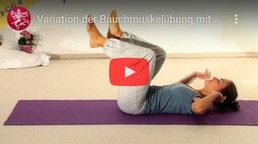
Special Effect of «Navasana» with isometric exercise
- Strengthens the flank muscles, arms and legs in addition to the abdominal muscles.
- Sets new stimuli and impulses in the Hatha Yoga Practice.
- Promotes even more stabilization from the center of the body and the body's center of gravity.
- Brings joy.
- Attention: Too strong muscles on the abdomen and flank, if hardened and shortened, can be a hindrance in «Pranayama».
Navasana with Hands on Head and Legs Crossed
A similar variation to «Navasana Simple Variation». You lie again in the «Back Relaxation Position»:
- Form the hands into a basket behind your head.
- The lower is back protected: the lower back is pressed into the ground and the abdomen is slightly tensed.
- The leg at 90 degree angle, knees above hips. Now wrap the right leg around the left leg so that the right knee is above the left knee.
- Raise the upper body and the head. Feel the abdominal muscles working now. Hold for 5-8 breaths.
- Return to middle. Building to the other side.
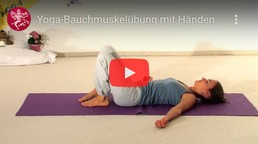
Navasana — Dynamic Abdominal Muscle Exercise
Starting Position «Back Relaxation Position» (typically in the Yoga Vidya Series):
- Bring both legs together. Protect the lower back and activate the abdominal muscles. Place the feet behind the buttocks. Raise the lower legs, the legs forming a 90 degree angle.
- Form a basket at the back of the head with the hands. Raise the head slightly, keeping the nape in line with the thoracic spine. Lift the upper body up with strength of abdominal muscles, less with strength of back muscles.
- Relax everything that you do not need for this Asana. Hold the position calmly and relaxed. Smile.
- Continue to breathe deeply into the abdomen. Feel how the abdominal muscles working, feel the warmth building. Exhaling bring the left elbow to your right knee. Extending thereby the left leg forward in the air. Inhaling return to the middle.
- Exhaling bring the right elbow to your left knee. The right leg is thereby extended forward in the air. Inhaling return to the middle.
- Guided by the breath, continue with this exercise dynamically.
- Go to your limits. Keep smiling. Come back to the middle.
- Dissolve the position slowly and consciously exhaling.
- Relax.
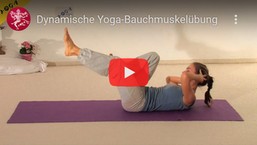
Variation Abdominal and Thigh Muscle Exercise
Exercise Video Abdominal and Thigh Muscle Exercise — Practical Instruction (Excerpt from a Yoga Beginners Lesson)
Sukadev guides you to the Abdominal and Thigh Muscle Exercise and shows you how to strengthen or tone in these areas.
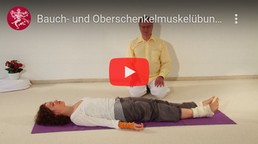
 |
 |
Exercise Video of Abdominal Muscle Exercises from Yoga with Different Variations
Intensify your Yoga Sport with our Videos!
Strengthen your Abdominal Muscles here with the «Navasana Variations», strenuous and highly effective Yoga Exercises for the straight, oblique and lateral abdominal muscles. Good for a toned abdomen and spinal health. The relaxation and awareness are at your center.
Attention: These exercises are strenuous! But they are fun and very good. It is enough to practice them 1-2 times a week. Under the guidance of a Yoga Teacher, you will learn the exercises even more thoroughly. You can attend Yoga Courses in any Yoga Centers and Yoga Seminar Houses of Yoga-Vidya. Find your suitable Yoga Course at https://www.yoga-vidya.de/seminare/.

 |
 |
Navasana on the Belly
This position is also often called «Navasana». Correctly, however, it is «Shalabhasana», the «Boat»:
Starting position «Abdominal Relaxation Position»:
- Bring the arms forward, palms facing each other.
- Gently raise the head, then the arms, shoulders away from the ears, arms at ear level.
- The pubic bone pressed into the ground, protect your lower back.
- Lift the leg preferably closed, otherwise the legs are slightly open.
- Hold for 5-8 breaths.
Counter-Position to Navasana or the Abdominal Muscle Exercise: Nakarasana or Garbhasana
Both postures are well suited as a counter-movement or balancing movement to «Navasana». In Hatha Yoga it is always important to switch to a «counter-position» after an Asana. This way you stay in balance on an energetic and physical level. Of course, you can also work with this consciously to balance imbalances. Always avoid creating new imbalances through one-sided practice.
Nakarasana, Crocodile
- «Nakarasana», the «Crocodile», stretches the muscles that were strengthened during «Navasana». You first lie on your back. The feet are close to the buttocks, the knees are drawn up. Gently drop the knees to the right. Thereby the knees remain closed and parallel.
- Tip: If you move your knees away from your chest in a relaxed sideways position, this will change the stretch point on your back. The further down the knees, the further down in the back the effect/stretch happens. And vice versa.
Garbhasana — Position of the Child
 «Garbhasana — Position of the Child»
«Garbhasana — Position of the Child»
«Garbhasana», the «Position of the Child» or the embryo posture, is a posture in which all muscles can relax. The practitioner sits in the «Heel Seat» and then he bends forward. While do so, he gives his upper body and the abdomen and on the thighs. The head can touch the ground, and the arms lie at the sides of the body. The flank breathing allows the practitioner to completely let go and relax into the position. The «Position of the Child» is held for 5 to 8 breaths.
Protecting the Lower Back — but how?
Normally, during «Navasana», the Yoga Teacher always announces this Asana in such a way that the lower back should be protected by «tightening the abdominal muscles and pressing the lower back into the ground», especially the lumbar region. Especially for people with weak back muscles in this area, this announcement is intended. This is how you protect yourself from injury. If the lower back muscles are well formed, for example, through sufficient practice of the «Locust», on the other hand it is sufficient for the teacher to simply say: «Protect the lower back and slightly tense the abdomen». In this way, the lower back does not have to be pressed completely into the ground. The natural curvature of the spine is S-shaped. This should remain so. Although the Yogi strives for a straight spine for his Meditation Posture, but nevertheless always relaxed. Not by deformations caused by incorrectly performed Asanas.
Even in today's gyms, attention is paid to the natural shape of the spine and appropriate announcements are refined. Just depending on the student and his problems. At Yoga-Vidya, one of the teaching principles is to strongly adapt to the student's ability and skills. If you are particularly interested in this topic, take a look at Back Yoga at Yoga Vidya.

